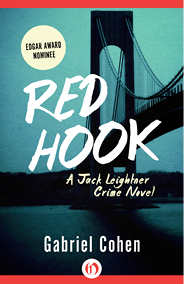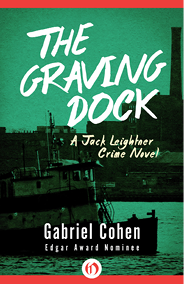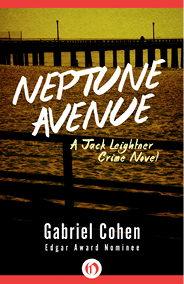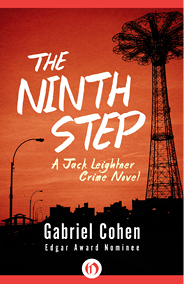Authors: Gabriel Cohen
Tags: #Fiction, #Mystery & Detective, #Police Procedural
The Ninth Step (30 page)
Everybody wanted a piece of Nadim Hasni now, but this time the feds would have to wait their turn.
Richie interrupted the young man. “You’re positive that the voices in the other cell belonged to Charlson and Brasciak?”
“I am positive,” Hasni said, almost weeping with relief; finally, he could tell what had really happened. He resumed his story. The detectives had a hard time keeping up their usual stoic front as he reached the part about his daughter’s death. Mercifully, then, some opiate drip kicked in; the man’s eyelids closed and he was fast asleep.
Jack and Richie sat in silence for a minute, contemplating the suspect they had desperately tracked across two boroughs, their supposed terrorist.
“Poor bastard,” Richie murmured.
Jack nodded. If Hasni managed to pull through, he would face homicide charges for the attack in the deli. But maybe he could plead temporary insanity. That could send him to a psych ward, but at least he might finally get some professional help to ease his anguished mind.
AFTER WORK, JACK STOPPED
in to Monsalvo’s for a beer. The place was quiet—just a couple of old-timers chatting companionably at the far end of the bar. Jack took a seat and stared up at the dusty deer head mounted on the wall. With its big sad eyeballs, it seemed to be staring back.
He sat there, sipping his beer, still musing about Nadim Hasni. He pictured the actual contents of the man’s deadly knapsack: two pairs of socks, some underwear, a couple of dirty T-shirts, and a half-eaten box of Oreo cookies. Simple things owned by a simple man, caught up in forces way beyond his control. The guy’s entire life had been ravaged. Who could possibly make that up to him?
Jack thought about the stranger who had showed up on his doorstep one recent Sunday morning, and he recalled the man’s crumpled piece of paper. What had it said? Something about taking stock of one’s life, and something about a Ninth Step:
making amends.
And then he was thinking not of his recent cases at all but of his father, of the many times he’d had to practically carry the man home from bars like this one, of the rages and the shouting. But he also remembered the time his father had helped him and Petey build a raft made of scraps of wood “recovered” from a construction site; they had actually managed to float it in a little waterfront cove. And his father holding him up in the Red Hook pool, then crowing to his friends when his son managed to dog-paddle a few feet on his own. His father, lifting three semiconscious men out of the hold of a burning, explosives-packed ship. Jack shook his head. He’d spent the past few days chasing a phantom threat to his beloved city, while all his life he had been completely ignorant about his own father’s role in saving the entire New York area from a very real and much greater cataclysm.
A 45 dropped into place in the jukebox: Bobby Darin, “Beyond the Sea.”
Jack sat there listening to the old tune, and he thought of Michelle. Most of his life, he had carried a heavy grudge against his old man; now he was carrying one against his former love. He pondered his visit to the little Buddhist nun and what she had told him about forgiveness. Yes, Michelle had cheated on him, but maybe she had just acted out of her own fear, her own insecurities. Maybe she was just another fallible human being. Who didn’t make mistakes?
He ducked his head and stared down into his glass. He knew now who he really needed to forgive: a fifteen-year-old boy who had said something stupid in an offhand moment. He hadn’t said it in order to cause any trouble for his brother. He had just been a kid, and the slurs had hopped out of his mouth like little wild sparrows. Petey was dead. No one could change the past, could make it right. But almost forty years had gone by. It would never be time to forget. But it was time to set his burden down.
And perhaps it was time to make some other changes, to find out what broken things might be repaired. He knew just where to start. He got up, strode across the bar’s faded linoleum floor, settled into the old phone booth, and shut the accordion door. Then he took out his cell phone and tapped in a number.
“Jack?” Michelle answered before he even said a word.
He blinked, wondering if his ex had somehow known he was about to call. And then, old-timer that he was, he remembered: there was no magic to it. Just caller ID.
“Is that really you?” she said. He could have been wrong, but he thought she sounded pleased.
For some silly reason, Jack thought about the homeless guy who’d earned three bucks off him in midtown Manhattan. “I’ll tell you where you got your shoes,” the man had said. “You got ’em on your own two feet.”
And so he did.
A
CRIME WRITER FRIEND
insists that he never researches his novels. “They’re
fiction
,” he says. “The important thing is to tell a good story. Who cares if the details are accurate?”
I’ve never been able to share that blithe approach. In part, that’s because I derive too much pleasure from the process of research, of going out and talking to real people, treading real settings, investigating real events. It’s also because I learned a lot about writing from working as a freelance journalist, and I know that I can pick up details from real life that are so rich, odd, and intriguing that I could probably never make them up.
That’s certainly the case with
The Ninth Step
. It’s a work of fiction and I hope it’s a good story, but—more than any of my other books—this one is based on a number of the most amazing true stories I’ve come across in two and a half decades of professional writing.
A few years ago, while working on a waterfront feature for
The New York Times
, I took a boat tour of little-known spots in New York Harbor. A four-sentence note in the accompanying leaflet mentioned the site of the near-explosion of a munitions ship called the
El Estero
back in 1943. I was captivated by this historical tidbit, which I had never heard of. My subsequent research culminated in a long and very pleasant interview with an eighty-eight-year-old man named Seymour Wittek. He had been a Coast Guardsman during that incredible event, and he was one of the volunteers who rushed to the burning ship, and he told me the tale which I have put into the mouth of my fictional character Frank Raucci.
Incredible as it may seem, except for the involvement of Raucci and of one particular Red Hook longshoreman and father, the story as told here is essentially accurate. Like the brave firemen and cops of 9/11, a small band of firemen and Coasties rushed forward when most of us would probably have been running as fast as we could in the other direction—and they saved the New York area from what could have been the greatest disaster in human history. It was one of the most astounding examples of human heroism I had ever heard of—so why, I wondered, was it not in every history book?
One reason, perhaps, is that—unlike 9/11—it was the tale of a catastrophe that
didn’t
happen. Also, the incident occurred in the middle of World War II, at a time when the U.S. Navy was hardly eager to broadcast the vulnerability of New York Harbor, so the story received little press attention. I’m glad to report that Seymour Wittek finally received a Coast Guard medal for his bravery on Veteran’s Day in 2008. He said that he accepted it on behalf of all the other guys who were no longer around.
Next true story. The Italian Mafia—in conjunction with a corrupt longshoremen’s union—really did have a stranglehold over the Brooklyn waterfront during the early and middle years of the twentieth century. A number of the notorious mafiosi mentioned in this book (Carmine Persico, Paul Castellano, Albert Anastasia, etc.) were real historical figures. A Red Hook native told me about his own father’s disappearances into the night in a car full of wiseguys—he never found out why—and that “Crazy” Joe Gallo really did have a front door presided over by a little person named Armando, and that overdue debtors in his loansharking operation were sent down to the basement to “talk to Leo.”
Third, the population of Little Pakistan in the heart of Brooklyn really was decimated by overzealous “anti-terror” raids in the months after 9/11. (I live a few blocks away.) I’m especially sorry to report that there was a real detention center that was used to hold suspected terrorists in Sunset Park, and that the civil and legal rights of hundreds of Muslim residents of New York City—many of them completely innocent—were thrown to the wind when they were rounded up, often without probable cause, and imprisoned there. I didn’t hear of any killings of prisoners at that facility, but a number of its guards later went on trial for subjecting prisoners to physical abuse and sexual humiliation, and it’s clear that a systematic breakdown in the rule of law occurred inside. These sad abuses were detailed in 2003 in a document (easily accessible online) called the “Supplemental Report on September 11 Detainees’ Allegations of Abuse at the Metropolitan Detention Center in Brooklyn, New York,” issued by the U.S. Department of Justice’s Office of the Inspector General, and in three hundred hours of secret videotapes which surfaced during the trials. (As someone who was living in New York just a couple of miles from Ground Zero on 9/11, I would never argue that there is not a real need for vigilance against terrorist acts or that a real threat does not exist. I
would
argue that abusing innocent civilians is not a good way to combat it.)
In late 2008, I stumbled across a few rather dubious news reports which claimed that Somali pirates who had captured an Iranian ship that summer subsequently began to die of what seemed like radiation sickness. I have no idea if there was
really
any truth to this story, but it certainly fired my imagination—and that of my fictional character Brent Charlson.
Last but not least, when I was doing my research for
Red Hook
, the first book in the Jack Leightner series, I spent some time going to meetings and otherwise exploring the fascinating world of Alcoholics Anonymous. I was hugely impressed by the courage of its members, who strive every day to face the reality of their problem, to be honest with themselves and others about their behavior, and to regain control of and to repair their lives. That’s when I learned about the Ninth Step.
ACKNOWLEDGMENTSGabriel Cohen
Brooklyn, 2010
I
NVALUABLE ASSISTANCE WITH THIS
book was provided by Reed Farrel Coleman, Robert Smith, Jonathan Green and Keisha Jones, and Gerard Raccuglia. Thank you!
A huge thanks to Seymour Wittek, member of a band of true heroes, who kindly shared his memories of one of the most incredible days in the history of New York City.
For information about a real terror plot in NYC, I turned to
Two Seconds Under the World: Terror Comes to America
—
The Conspiracy Behind the World Trade Center Bombing
by Jim Dwyer, David Kocieniewski, Deidre Murphy, and Peg Tyre. For information about the world under the Coney Island boardwalk, I perused the photographs of Nathan Kensinger, at kensinger.blogspot.com.
Thanks to Roxanne Aubrey, as always, for help with my Web site.
And a special thanks to Vicky Bijur, for wise advice and extraordinary representation.
Gabriel Cohen’s debut novel,
Red Hook
, was nominated for the Edgar Award for Best First Novel. He wrote three more mystery novels featuring Brooklyn South Homicide Task Force detective Jack Leightner:
The Graving Dock
,
Neptune Avenue
, and
The Ninth Step
. He is also the author of
Boombox
, a novel, and
Storms Can’t Hurt the Sky: A Buddhist Path Through Divorce
. He teaches in the writing program at Pratt Institute and loves living in Brooklyn, whose spirited, incredibly diverse neighborhoods provide him with a limitless source of vivid material. His website is
www.gabrielcohenbooks.com
.
All rights reserved, including without limitation the right to reproduce this ebook or any portion thereof in any form or by any means, whether electronic or mechanical, now known or hereinafter invented, without the express written permission of the publisher.
This is a work of fiction. Names, characters, places, events, and incidents either are the product of the author’s imagination or are used fictitiously. Any resemblance to actual persons, living or dead, businesses, companies, events, or locales is entirely coincidental.
Copyright © 2010 by Gabriel Cohen
Cover design by Mauricio Diaz
978-1-4804-6718-7
This edition published in 2014 by Open Road Integrated Media, Inc.
345 Hudson Street
New York, NY 10014






